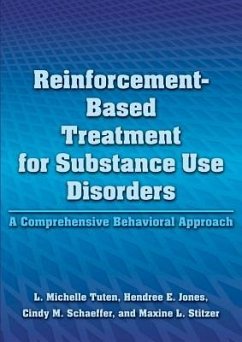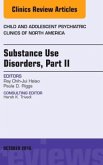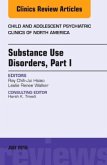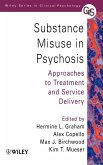L. Michelle Tuten, Hendree E. Jones, Cindy M. Schaeffer
Reinforcement-Based Treatment for Substance Use Disorders: A Comprehensive Behavioral Approach
L. Michelle Tuten, Hendree E. Jones, Cindy M. Schaeffer
Reinforcement-Based Treatment for Substance Use Disorders: A Comprehensive Behavioral Approach
- Gebundenes Buch
- Merkliste
- Auf die Merkliste
- Bewerten Bewerten
- Teilen
- Produkt teilen
- Produkterinnerung
- Produkterinnerung
An introduction for clinicians on the theory and practice of Reinforcement-Based Treatment (RBT) in substance abuse treatment. Its aim is to help clinicians implement RBT methods or integrate RBT into their own substance-abuse treatment practice.
Andere Kunden interessierten sich auch für
![Substance Abuse and Emotion Substance Abuse and Emotion]() Substance Abuse and Emotion35,99 €
Substance Abuse and Emotion35,99 €![Substance and Behavioral Addictions Substance and Behavioral Addictions]() Steve SussmanSubstance and Behavioral Addictions149,99 €
Steve SussmanSubstance and Behavioral Addictions149,99 €![Substance Use Disorders: Part II, an Issue of Child and Adolescent Psychiatric Clinics of North America Substance Use Disorders: Part II, an Issue of Child and Adolescent Psychiatric Clinics of North America]() Ray Chih-Jui HsiaoSubstance Use Disorders: Part II, an Issue of Child and Adolescent Psychiatric Clinics of North America115,99 €
Ray Chih-Jui HsiaoSubstance Use Disorders: Part II, an Issue of Child and Adolescent Psychiatric Clinics of North America115,99 €![Substance Use Disorders: Part I, an Issue of Child and Adolescent Psychiatric Clinics of North America Substance Use Disorders: Part I, an Issue of Child and Adolescent Psychiatric Clinics of North America]() Ray Chih-Jui HsiaoSubstance Use Disorders: Part I, an Issue of Child and Adolescent Psychiatric Clinics of North America116,99 €
Ray Chih-Jui HsiaoSubstance Use Disorders: Part I, an Issue of Child and Adolescent Psychiatric Clinics of North America116,99 €![Substance Misuse in Psychosis Substance Misuse in Psychosis]() Substance Misuse in Psychosis270,99 €
Substance Misuse in Psychosis270,99 €![A Handbook on Drug and Alcohol Abuse A Handbook on Drug and Alcohol Abuse]() Gail WingerA Handbook on Drug and Alcohol Abuse59,99 €
Gail WingerA Handbook on Drug and Alcohol Abuse59,99 €![A Handbook on Drug and Alcohol Abuse A Handbook on Drug and Alcohol Abuse]() Gail WingerA Handbook on Drug and Alcohol Abuse105,99 €
Gail WingerA Handbook on Drug and Alcohol Abuse105,99 €-
-
-
An introduction for clinicians on the theory and practice of Reinforcement-Based Treatment (RBT) in substance abuse treatment. Its aim is to help clinicians implement RBT methods or integrate RBT into their own substance-abuse treatment practice.
Hinweis: Dieser Artikel kann nur an eine deutsche Lieferadresse ausgeliefert werden.
Hinweis: Dieser Artikel kann nur an eine deutsche Lieferadresse ausgeliefert werden.
Produktdetails
- Produktdetails
- Verlag: American Psychological Association (APA)
- Seitenzahl: 293
- Erscheinungstermin: August 2011
- Englisch
- Abmessung: 259mm x 183mm x 20mm
- Gewicht: 703g
- ISBN-13: 9781433810244
- ISBN-10: 1433810247
- Artikelnr.: 33637009
- Herstellerkennzeichnung
- Libri GmbH
- Europaallee 1
- 36244 Bad Hersfeld
- gpsr@libri.de
- Verlag: American Psychological Association (APA)
- Seitenzahl: 293
- Erscheinungstermin: August 2011
- Englisch
- Abmessung: 259mm x 183mm x 20mm
- Gewicht: 703g
- ISBN-13: 9781433810244
- ISBN-10: 1433810247
- Artikelnr.: 33637009
- Herstellerkennzeichnung
- Libri GmbH
- Europaallee 1
- 36244 Bad Hersfeld
- gpsr@libri.de
L. Michelle Tuten, Hendree E. Jones, Cindy M. Schaeffer, and Maxine L. Stitzer
Introduction
I. Core Program Features
1. The Atmosphere of Treatment Delivery
2. Conducting a Functional Assessment of Substance Use
3. The Feedback Session: An Adaptation of Motivational Interviewing
4. Essential Goals for Competing With Drug Use
5. Behavioral Monitoring of Treatment Goals: Goal Graphing
6. Contingency Management to Improve Treatment Outcomes
7. The Role of Case Management in Substance Abuse Treatment
8. The Role of Significant Others and Family Members in Substance Abuse
Treatment
II. Program Administration
1. Training and Supervision
2. Implementation Challenges
III. Special Populations
1. Pregnant and Child-Rearing Women
2. Parents in the Child Welfare System
Afterword: Future Directions for Practice and Research
* Appendix A: New Client Welcome Certificate
* Appendix B: Functional Assessment of Drug Use
* Appendix C: Functional Assessment for Relapse
* Appendix D: Client Feedback Form
* Appendix E: Client Feedback Pamphlet
* Appendix F: Day Plan
* Appendix G: Abstinence Sampling Contract
* Appendix H: Alternative Housing Plan
* Appendix I: Tracking Locator Form
* Appendix J: Cost-Benefit Analysis
* Appendix K: Treatment Team,Treatment Plan Elements, and Key Decisions
* Appendix L: Sample Initial Treatment Plan for Pregnant and
Child-Rearing Women
References
Index
About the Authors
I. Core Program Features
1. The Atmosphere of Treatment Delivery
2. Conducting a Functional Assessment of Substance Use
3. The Feedback Session: An Adaptation of Motivational Interviewing
4. Essential Goals for Competing With Drug Use
5. Behavioral Monitoring of Treatment Goals: Goal Graphing
6. Contingency Management to Improve Treatment Outcomes
7. The Role of Case Management in Substance Abuse Treatment
8. The Role of Significant Others and Family Members in Substance Abuse
Treatment
II. Program Administration
1. Training and Supervision
2. Implementation Challenges
III. Special Populations
1. Pregnant and Child-Rearing Women
2. Parents in the Child Welfare System
Afterword: Future Directions for Practice and Research
* Appendix A: New Client Welcome Certificate
* Appendix B: Functional Assessment of Drug Use
* Appendix C: Functional Assessment for Relapse
* Appendix D: Client Feedback Form
* Appendix E: Client Feedback Pamphlet
* Appendix F: Day Plan
* Appendix G: Abstinence Sampling Contract
* Appendix H: Alternative Housing Plan
* Appendix I: Tracking Locator Form
* Appendix J: Cost-Benefit Analysis
* Appendix K: Treatment Team,Treatment Plan Elements, and Key Decisions
* Appendix L: Sample Initial Treatment Plan for Pregnant and
Child-Rearing Women
References
Index
About the Authors
Introduction
I. Core Program Features
1. The Atmosphere of Treatment Delivery
2. Conducting a Functional Assessment of Substance Use
3. The Feedback Session: An Adaptation of Motivational Interviewing
4. Essential Goals for Competing With Drug Use
5. Behavioral Monitoring of Treatment Goals: Goal Graphing
6. Contingency Management to Improve Treatment Outcomes
7. The Role of Case Management in Substance Abuse Treatment
8. The Role of Significant Others and Family Members in Substance Abuse
Treatment
II. Program Administration
1. Training and Supervision
2. Implementation Challenges
III. Special Populations
1. Pregnant and Child-Rearing Women
2. Parents in the Child Welfare System
Afterword: Future Directions for Practice and Research
* Appendix A: New Client Welcome Certificate
* Appendix B: Functional Assessment of Drug Use
* Appendix C: Functional Assessment for Relapse
* Appendix D: Client Feedback Form
* Appendix E: Client Feedback Pamphlet
* Appendix F: Day Plan
* Appendix G: Abstinence Sampling Contract
* Appendix H: Alternative Housing Plan
* Appendix I: Tracking Locator Form
* Appendix J: Cost-Benefit Analysis
* Appendix K: Treatment Team,Treatment Plan Elements, and Key Decisions
* Appendix L: Sample Initial Treatment Plan for Pregnant and
Child-Rearing Women
References
Index
About the Authors
I. Core Program Features
1. The Atmosphere of Treatment Delivery
2. Conducting a Functional Assessment of Substance Use
3. The Feedback Session: An Adaptation of Motivational Interviewing
4. Essential Goals for Competing With Drug Use
5. Behavioral Monitoring of Treatment Goals: Goal Graphing
6. Contingency Management to Improve Treatment Outcomes
7. The Role of Case Management in Substance Abuse Treatment
8. The Role of Significant Others and Family Members in Substance Abuse
Treatment
II. Program Administration
1. Training and Supervision
2. Implementation Challenges
III. Special Populations
1. Pregnant and Child-Rearing Women
2. Parents in the Child Welfare System
Afterword: Future Directions for Practice and Research
* Appendix A: New Client Welcome Certificate
* Appendix B: Functional Assessment of Drug Use
* Appendix C: Functional Assessment for Relapse
* Appendix D: Client Feedback Form
* Appendix E: Client Feedback Pamphlet
* Appendix F: Day Plan
* Appendix G: Abstinence Sampling Contract
* Appendix H: Alternative Housing Plan
* Appendix I: Tracking Locator Form
* Appendix J: Cost-Benefit Analysis
* Appendix K: Treatment Team,Treatment Plan Elements, and Key Decisions
* Appendix L: Sample Initial Treatment Plan for Pregnant and
Child-Rearing Women
References
Index
About the Authors








